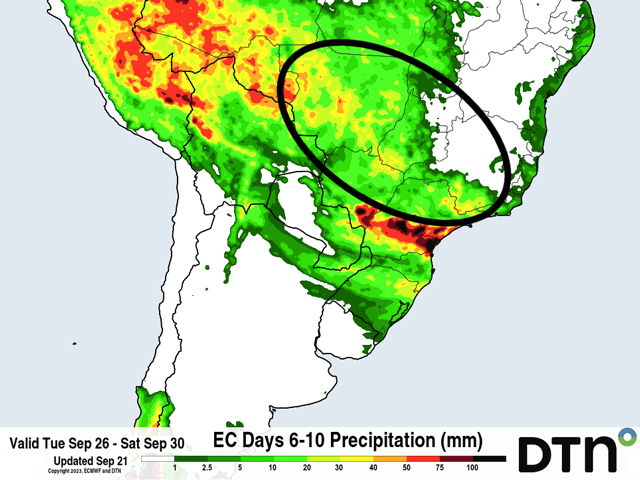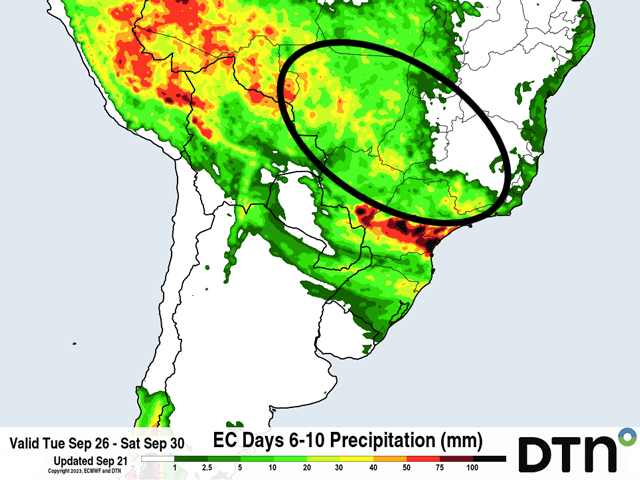Ag Weather Forum
Start to Brazil's Rainy Season in Sight
Central Brazil is so close to the equator that seasons come with precipitation instead of temperature. Being in the tropics means cool temperatures do not really exist. Instead, the seasons are characterized by periods of nearly absolute dryness and periods of near-daily rainfall. The dry season has been in place since May, when the last 30 millimeters (about 1.2 inches) of rain fell in the states of Mato Grosso, Goias, and Minas Gerais. When those rains return, we usually start up the rainy, or wet season, characterized by some as the first 30 millimeters of rainfall after the prolonged dry season. However, we saw heavier rain in late August and early September in a lot of those areas that exceeded that 30-millimeter threshold. Typically, the wet season rains return at the end of September. On average, that date is around Sept. 26. Some isolated lighter rains have developed since then, but it has been much drier. It would be hard to characterize the earlier rains as the true start to the wet season, so we continue to look for it.
That average date is fast approaching and farmers in central Brazil rely on a timely start to double-crop soybeans and corn. Delays to the start of the wet season can result in disastrous crops, mostly for the second-season (safrinha) corn crop. Producers try to get the first-crop soybeans harvested and safrinha corn immediately planted in late January and February if all goes well. The corn crop then can get through pollination before the wet season rains shut down in early May. With delays to the wet season, it puts the safrinha corn crop at risk of going dry before reaching pollination. Such was the case in the 2020-2021 crop season which had a two-week delay to the beginning of the wet season and a three-week early end in mid-April. The corn crop was more exposed to rare frosts in June and July that cut production as well. Needless to say, timely rains at the beginning of the season are paramount to a potential good crop.
Sometimes a front is all it takes to get things going and the daily rains follow, increasing in intensity throughout October with the heart of the wet season from November through March. There just so happens to be a stalled front across northern Argentina and southern Brazil. The front will continue to produce showers into next week. Models have that front lifting northward into central Brazil around Sept. 26-27 and stalling, producing increasing rain coverage and intensity for the rest of next week. Longer-range models are insistent that rain showers increase then throughout October. Should this front linger, and the forecast pan out, the wet season would start on time.
P[L1] D[0x0] M[300x250] OOP[F] ADUNIT[] T[]
However, those same models have below-normal rainfall amounts forecast for much of the month. That is typical of El Nino. While the rainy season usually starts near normal, the amount of rainfall is often reduced throughout the season. When the state of Mato Grosso averages 180-250 millimeters (about seven to ten inches) each month during the rainy season, below-normal rainfall does not look like it would have a huge impact on crop development. But there are two main factors that may arise with lower wet season rainfall.
The first would be with the soybean crop. With soil moisture largely at a minimum, heavy rainfall early is needed to moisten soils for good seed-to-soil contact and early establishment to help with uniform germination. Delays in germination could delay harvest and subsequent safrinha corn planting. Early moisture may have already helped in this regard, however.
The second is that with the safrinha crop relying on stored moisture to complete its fill period, reductions in wet season rainfall can play a role in reducing potential for putting on test weight, reducing yields. The start of the wet season is only the first hurdle facing central Brazilian farmers.
**
To find more international weather conditions and your local forecast from DTN, visit https://www.dtnpf.com/….
John Baranick can be reached at john.baranick@dtn.com
(c) Copyright 2023 DTN, LLC. All rights reserved.






Comments
To comment, please Log In or Join our Community .